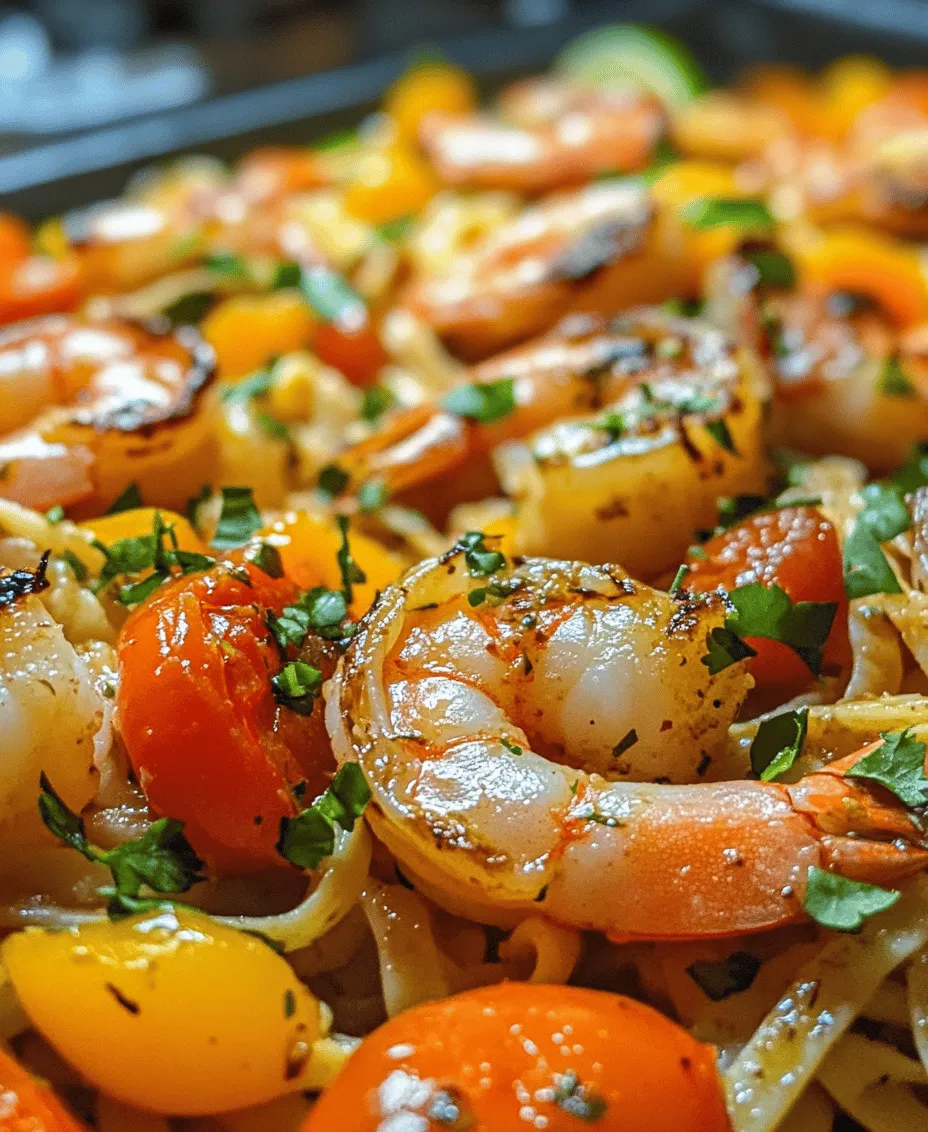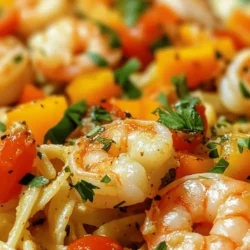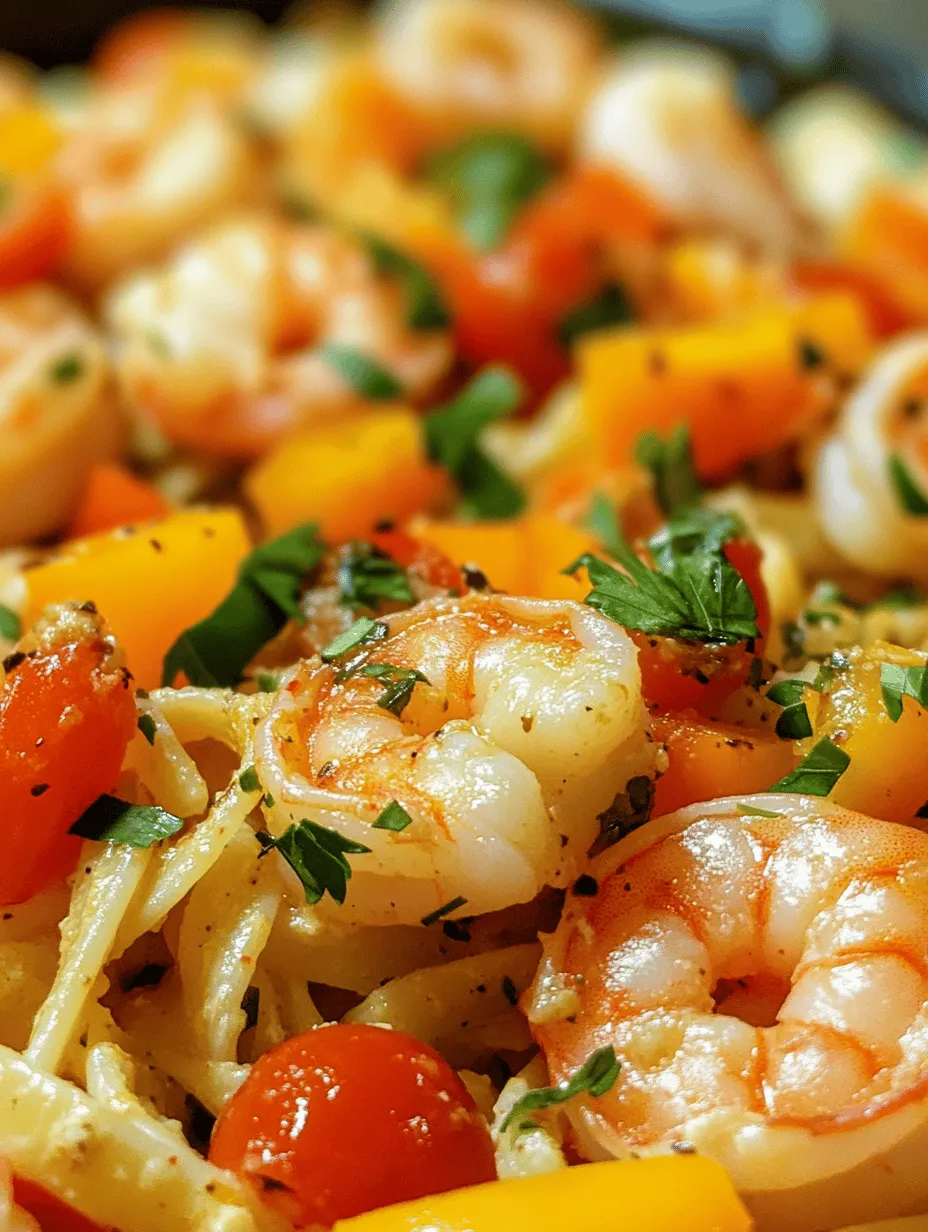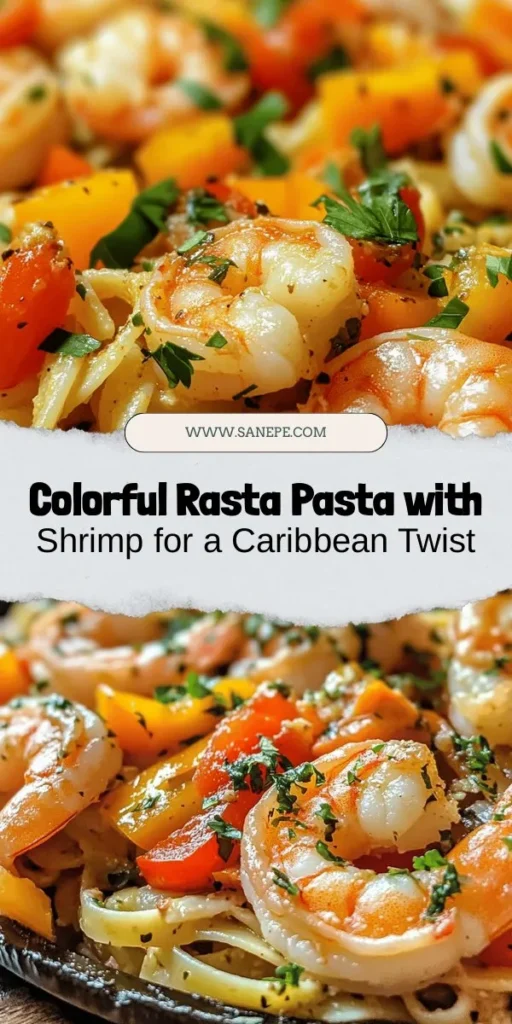Introduction
Rasta Pasta is an enchanting fusion dish that brings together the vibrant flavors of Caribbean cuisine with the comforting textures of Italian pasta. This delightful recipe features succulent shrimp tossed with colorful vegetables and bathed in a creamy coconut sauce, creating a meal that is as visually appealing as it is tasty. The popularity of Rasta Pasta has soared in contemporary culinary trends, particularly among food enthusiasts looking to explore innovative ways to enjoy traditional dishes. It’s a perfect representation of the growing interest in global cuisine, where boundaries blur, and flavors collide.
One of the most important aspects of crafting the perfect Rasta Pasta is using fresh, high-quality ingredients. Fresh produce not only enhances the dish’s flavor profile but also contributes essential nutrients, making your meal wholesome and satisfying. Whether you’re preparing this dish for a casual family dinner or an impressive gathering, the use of vibrant, fresh ingredients will undoubtedly elevate your cooking game.
Understanding Rasta Pasta
Origins of Rasta Pasta
Rasta Pasta has its roots in Jamaica, where the fusion of different culinary traditions has created a unique and exciting dining experience. The dish draws inspiration from the Rastafarian culture, which embraces natural and organic foods, often highlighting the use of fresh vegetables and seafood. The blend of Caribbean spices and Italian pasta reflects the multicultural influences that define modern Jamaican cuisine.
The origins of Rasta Pasta can be traced back to the Caribbean’s rich agricultural landscape and its access to fresh seafood. This culinary innovation showcases how different cultures can come together through food, leading to the creation of dishes that are both flavorful and representative of their heritage. As food trends continue to evolve, Rasta Pasta remains a beloved choice for those seeking something new yet comforting.
The Role of Seafood in Caribbean Cuisine
Seafood plays a significant role in Caribbean cooking, with shrimp being one of the most popular choices among chefs and home cooks alike. The warm waters surrounding the islands provide an abundance of fresh seafood, making it a staple ingredient in many traditional dishes. Shrimp, in particular, is celebrated for its delicate flavor and versatility, pairing beautifully with a variety of sauces and seasonings.
Incorporating shrimp into Rasta Pasta not only enhances the dish’s flavor but also adds valuable nutritional benefits. Shrimp is a low-calorie source of protein that is rich in essential nutrients, including selenium, vitamin B12, and iodine. These nutrients support overall health, making shrimp a great addition to any balanced diet. By combining shrimp with colorful vegetables and creamy coconut milk, Rasta Pasta offers a meal that is both satisfying and nutritious.
Nutritional Benefits of Incorporating Shrimp and Vegetables
The combination of shrimp and fresh vegetables in Rasta Pasta not only creates a dish bursting with flavor but also provides numerous health benefits. Vegetables such as bell peppers, onions, and cherry tomatoes are rich in essential vitamins and minerals, including vitamin C, potassium, and dietary fiber. These nutrients contribute to overall health, support immune function, and promote digestive health.
Additionally, the inclusion of coconut milk adds a creamy texture to the dish while offering health benefits of its own. Coconut milk is a source of healthy fats, particularly medium-chain triglycerides (MCTs), which may support weight management and provide a quick source of energy. Together, the ingredients in Rasta Pasta create a balanced meal that satisfies both taste buds and nutritional needs.
Ingredient Breakdown
To achieve the best results when making Rasta Pasta with Shrimp, it’s essential to understand the significance of each ingredient used in the recipe. Below, we break down the main components to help you create a mouthwatering dish.
Overview of the Main Ingredients and Their Significance
1. Pasta: The foundation of Rasta Pasta is, of course, the noodles. Fettuccine and penne are two popular choices, each offering a different texture and experience. Fettuccine, with its wide and flat shape, pairs well with creamy sauces, while penne, with its tubular shape, catches bits of sauce and vegetables beautifully.
2. Shrimp: As a key protein in this dish, shrimp adds not only flavor but also a satisfying texture. Opt for fresh or high-quality frozen shrimp to ensure the best taste. When selecting shrimp, look for those that are firm, translucent, and have a mild sea breeze scent.
3. Fresh Vegetables: The vibrant colors and flavors of the vegetables used in Rasta Pasta are crucial to the dish’s appeal. Onions add sweetness and depth, while bell peppers bring crunch and a hint of bitterness. Cherry tomatoes add a burst of juicy flavor that balances the creaminess of the sauce.
4. Coconut Milk: A staple in Caribbean cooking, coconut milk provides a rich and creamy base for the sauce. It imparts a subtle sweetness and tropical flavor that complements the shrimp and vegetables perfectly. Additionally, coconut milk is a dairy-free alternative, making it suitable for various dietary preferences.
5. Jerk Seasoning: This quintessential Caribbean spice blend is what makes Rasta Pasta truly unique. Jerk seasoning typically includes a combination of allspice, thyme, cinnamon, nutmeg, and scotch bonnet peppers, providing a complex flavor profile that adds warmth and depth to the dish.
Pasta Selection: Choosing Between Fettuccine and Penne
When it comes to choosing the right pasta for your Rasta Pasta, both fettuccine and penne have their merits. Fettuccine offers a broader surface area that allows the creamy sauce to cling beautifully, enhancing each bite’s flavor. On the other hand, penne’s tubular shape makes it an excellent choice for capturing the sauce and vegetables, ensuring a well-rounded experience.
Ultimately, the choice between fettuccine and penne comes down to personal preference. For a more traditional Italian feel, fettuccine is a fantastic option. If you prefer a heartier bite, penne might be your best bet. Experiment with both to find your favorite!
The Importance of Shrimp: Sourcing and Selecting Quality Seafood
Selecting quality shrimp is paramount to creating a delicious Rasta Pasta. When sourcing shrimp, consider purchasing from local fish markets or reputable grocery stores that prioritize sustainability. Look for shrimp that is either wild-caught or farmed responsibly. This not only supports local economies but also ensures that you are consuming seafood that is free from harmful chemicals and additives.
When selecting shrimp, consider the following tips:
– Size Matters: Shrimp come in various sizes, typically measured by the number of shrimp per pound. For Rasta Pasta, medium to large shrimp is ideal, as they provide a satisfying bite without overpowering the other ingredients.
– Freshness: Fresh shrimp should have a mild, briny scent and firm texture. If using frozen shrimp, ensure they are properly thawed before cooking to maintain their quality.
– Shell-on or Peeled: While shell-on shrimp can enhance flavor during cooking, peeled shrimp are more convenient for quick preparation. Choose according to your cooking style and preferences.
Highlighting Fresh Vegetables: Onion, Bell Pepper, Cherry Tomatoes, and Their Flavors
The fresh vegetables in Rasta Pasta not only add vibrancy and color but also contribute essential flavors and nutrition. Each vegetable plays a distinct role in the overall flavor profile of the dish:
– Onions: Sautéed until translucent, onions provide a sweet and savory base that complements the other ingredients. They also contribute to the dish’s aromatic qualities, enhancing the overall dining experience.
– Bell Peppers: These colorful vegetables add a delightful crunch and a touch of sweetness. Red, yellow, or green bell peppers can be used, each offering a slightly different flavor. Their bright hues also enhance the dish’s visual appeal.
– Cherry Tomatoes: Bursting with sweetness, cherry tomatoes bring a refreshing contrast to the creamy sauce. Their juicy texture adds depth, making each bite a delightful experience.
Coconut Milk: A Staple in Caribbean Cooking and Its Health Benefits
Coconut milk is a key ingredient in Rasta Pasta, lending its creamy texture and tropical flavor. This rich, dairy-free alternative not only elevates the dish but also offers numerous health benefits. Rich in MCTs, coconut milk can provide a quick source of energy and may aid in weight management by promoting a feeling of fullness.
Additionally, coconut milk contains essential vitamins, minerals, and antioxidants that support overall health. Its natural sweetness complements the savory elements of the dish, creating a harmonious balance of flavors that is characteristic of Caribbean cuisine.
Seasoning Profile: Understanding Jerk Seasoning and Its Role in Flavor Development
Jerk seasoning is the heart and soul of Rasta Pasta, infusing the dish with its signature bold flavors. This spice blend is rooted in Jamaican culinary traditions and typically includes a mixture of allspice, thyme, cinnamon, nutmeg, black pepper, and scotch bonnet peppers. Each spice contributes its unique flavor, creating a complex and aromatic profile that elevates the dish to new heights.
When using jerk seasoning for Rasta Pasta, it’s important to balance the flavors to suit your taste. If you prefer a milder heat, consider using less scotch bonnet or opting for a milder jerk seasoning blend. The key is to find the right balance that enhances the overall flavor without overwhelming the dish.
Optional Ingredient Variations for Dietary Preferences
One of the great things about Rasta Pasta is its versatility. You can easily adapt the recipe to accommodate various dietary preferences and restrictions. Here are some optional ingredient variations to consider:
– Vegetarian Option: For a vegetarian version, simply omit the shrimp and replace it with additional vegetables or plant-based protein sources such as tofu or chickpeas.
– Gluten-Free Option: If you’re following a gluten-free diet, substitute regular pasta with gluten-free pasta made from rice, corn, or chickpeas. Ensure that all other ingredients, including jerk seasoning, are gluten-free as well.
– Dairy-Free: While coconut milk is already dairy-free, you can enhance the creaminess by adding blended cashews or nutritional yeast for a cheesy flavor without dairy.
– Customizable Vegetables: Feel free to incorporate other vegetables based on your preferences or seasonal availability. Zucchini, spinach, or snap peas can add unique flavors and textures to your Rasta Pasta.
Step-by-Step Cooking Instructions
Now that you have a solid understanding of the ingredients and their significance, it’s time to dive into the step-by-step cooking instructions for creating your own delicious Rasta Pasta with Shrimp.
1. Prepare the Ingredients: Start by washing and chopping your vegetables. Dice the onion, slice the bell peppers into thin strips, and halve the cherry tomatoes. Ensure your shrimp is peeled and deveined, ready to be sautéed.
2. Cook the Pasta: Bring a large pot of salted water to a boil. Add your choice of pasta and cook according to the package instructions until al dente. Reserve about a cup of pasta water, then drain and set aside the cooked pasta.
3. Sauté the Vegetables: In a large skillet over medium heat, add a drizzle of oil. Once hot, add the diced onion and sauté until translucent. Follow with the bell peppers, cooking until they soften. Finally, add the cherry tomatoes and cook until they begin to burst.
4. Add the Shrimp: Push the vegetables to one side of the skillet, then add the shrimp to the empty space. Season with jerk seasoning, and cook until the shrimp turns pink and opaque, about 2-3 minutes per side.
5. Create the Sauce: Once the shrimp is cooked, stir in the coconut milk, mixing it with the sautéed vegetables and shrimp. Allow the sauce to simmer for a couple of minutes, letting the flavors combine. If the sauce is too thick, add a splash of reserved pasta water to reach your desired consistency.
6. Combine with Pasta: Add the cooked pasta to the skillet, tossing everything together until the pasta is well coated in the creamy sauce. Adjust seasoning as needed, adding more jerk seasoning or salt to taste.
7. Serve and Enjoy: Plate your Rasta Pasta with Shrimp, garnishing with fresh herbs like cilantro or parsley if desired. Enjoy the burst of Caribbean flavors in each delightful bite!
As you venture into crafting this vibrant and flavorful dish, remember that Rasta Pasta is not just about the ingredients but also the love and creativity you bring into the kitchen. With each step, you’ll discover how simple ingredients can transform into a culinary masterpiece that reflects the beauty of fusion cuisine. Enjoy the journey and the delicious outcome!

Cooking the Pasta: Tips for Achieving the Perfect Al Dente Texture
To achieve the perfect al dente pasta for your Rasta Pasta with Shrimp, start by using a large pot filled with water. The general rule of thumb is to use about 4 to 6 quarts of water for every pound of pasta. Add a generous amount of salt to the water; this enhances the flavor of the pasta as it cooks. Bring the water to a rolling boil before adding the pasta to ensure it cooks evenly.
Once the pasta is added, stir it gently to prevent sticking. Cook according to the package instructions, usually around 8 to 12 minutes, depending on the type of pasta you choose. To test for doneness, taste a piece a minute or two before the suggested cooking time; it should be firm yet tender. When the pasta reaches the desired texture, reserve about a cup of the pasta cooking water for later use in the sauce, and then drain the pasta in a colander. Avoid rinsing the pasta, as this removes the starch that helps the sauce adhere.
Sautéing Vegetables: Techniques for Enhancing Flavors Through Proper Cooking Methods
Sautéing vegetables is a critical step in building the foundation of flavor for your Rasta Pasta with Shrimp. Begin by heating olive oil or coconut oil in a large skillet over medium heat. Once the oil is hot, add your chopped bell peppers, onions, and any other aromatic vegetables like carrots or zucchini.
Sauté the vegetables for about 5 to 7 minutes, stirring frequently, until they become tender and start to caramelize. This caramelization process brings out the natural sweetness and deepens the flavor of the vegetables. Make sure not to overcrowd the pan; if necessary, sauté in batches. Once the vegetables are tender and fragrant, remove them from the skillet and set them aside while you prepare the rest of the dish.
Incorporating Garlic and Tomatoes: The Importance of Building Flavor Layers
After removing the sautéed vegetables, it’s time to incorporate garlic and tomatoes into the skillet. Add a little more oil if needed, and once hot, toss in minced garlic. Sauté the garlic for about 30 seconds until it’s fragrant but not browned, as burnt garlic can impart a bitter taste to your dish.
Next, add diced tomatoes, either fresh or canned, to the skillet. Cook the mixture for an additional 3 to 5 minutes, allowing the tomatoes to break down and mingle with the garlic. This step is essential for developing a rich, flavorful base for your sauce. As the tomatoes cook, they will release their juices, creating a deliciously tangy liquid that will enhance the overall flavor of your Rasta Pasta.
Cooking the Shrimp: Best Practices for Ensuring Shrimp is Cooked Perfectly
Cooking the shrimp is a crucial step that requires attention to avoid overcooking. Start by ensuring your shrimp are peeled and deveined. If using frozen shrimp, allow them to thaw completely before cooking.
In the same skillet with the tomato-garlic mixture, add the shrimp in a single layer. Cook them for about 2 to 3 minutes on one side, then flip them over to cook for an additional 1 to 2 minutes. The shrimp are done when they turn pink and opaque. Overcooking can lead to rubbery shrimp, so keep an eye on them.
Once cooked, remove the shrimp from the skillet and set them aside while you prepare the sauce.
Creating the Sauce: Balancing Flavors with Coconut Milk and Spices
The sauce is where the magic happens, bringing all the elements of your Rasta Pasta together. In the same skillet, pour in a can of coconut milk, scraping up any browned bits left from the shrimp and vegetables. The coconut milk adds a creamy texture and a hint of sweetness that balances the dish’s flavors.
Add in spices such as paprika, cayenne pepper, and thyme to give the sauce a Caribbean flair. Adjust the spices according to your heat preference, as some may prefer a milder sauce while others enjoy a bit more kick. Allow the sauce to simmer for about 5 to 7 minutes, letting it thicken slightly while the flavors meld together. Taste and adjust seasoning with salt and pepper as needed.
Combining Ingredients: Techniques for Achieving a Well-Mixed Dish
Once your sauce is ready, it’s time to bring everything together. Add the cooked pasta to the skillet, along with the sautéed vegetables and cooked shrimp. Use tongs or a spatula to gently toss the ingredients together, ensuring the pasta is evenly coated with the rich sauce. If the mixture seems too thick, add a splash of the reserved pasta water to loosen it up while enhancing the starchy flavor.
Continue to toss everything over low heat for a minute or two to allow the flavors to combine fully. This step is crucial for ensuring that every bite of pasta is infused with the delicious flavors of the sauce, shrimp, and vegetables.
Finishing Touches: Enhancing Presentation and Flavor with Lime Juice and Fresh Herbs
To elevate your Rasta Pasta with Shrimp, finish with a squeeze of fresh lime juice. This adds a bright, zesty note that contrasts beautifully with the creamy sauce.
For a pop of color and freshness, chop fresh herbs like cilantro or parsley and sprinkle them generously over the dish before serving. Not only do herbs enhance the presentation, but they also contribute additional layers of flavor. Serve the pasta in bowls, garnished with lime wedges for an extra touch.
Flavor Profiles and Pairing Suggestions
The overall flavor profile of Rasta Pasta with Shrimp is a delightful balance of creaminess from the coconut milk, sweetness from the sautéed vegetables, and a hint of spice from the seasonings. The shrimp add a satisfying protein element that complements the pasta perfectly, making each bite a medley of flavors.
For side dishes, consider pairing your Rasta Pasta with a fresh garden salad drizzled with a citrus vinaigrette or some crusty garlic bread to soak up the delicious sauce. Both options provide a refreshing contrast to the richness of the pasta.
When it comes to beverages, tropical drinks like a mango smoothie or piña colada work wonderfully to enhance the Caribbean theme of this dish. If you prefer wine, opt for a chilled Sauvignon Blanc or a light-bodied Pinot Grigio to balance the flavors without overpowering them.
Nutritional Information
A serving of Rasta Pasta with Shrimp typically contains around 550 calories, making it a filling yet balanced meal. It is rich in important nutrients, primarily due to the shrimp, coconut milk, and various vegetables included in the dish.
– Calories: Approximately 550 per serving
– Protein: Shrimp is an excellent source of lean protein, contributing around 20 grams per serving.
– Healthy Fats: Coconut milk offers healthy fats, which are beneficial for heart health.
– Vitamins and Minerals: The inclusion of bell peppers and tomatoes adds a variety of vitamins (such as Vitamin C and A) and minerals (such as potassium).
This dish provides a balanced mix of carbohydrates from the pasta, protein from the shrimp, and healthy fats from coconut milk, making it a wholesome meal option.
Conclusion
In conclusion, Rasta Pasta with Shrimp is not only a delicious dish but also a versatile recipe that brings the vibrant flavors of the Caribbean right to your dining table. The combination of creamy coconut milk, succulent shrimp, and colorful vegetables makes it enticing and satisfying.
Embrace the joy of cooking and explore the rich tapestry of Caribbean flavors through this recipe. Whether you’re preparing it for a casual family dinner or a festive gathering, Rasta Pasta with Shrimp is sure to impress and delight your loved ones. So gather your ingredients, unleash your culinary creativity, and savor the experience of sharing this delightful meal with those who matter most.


